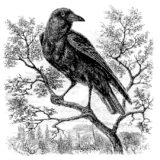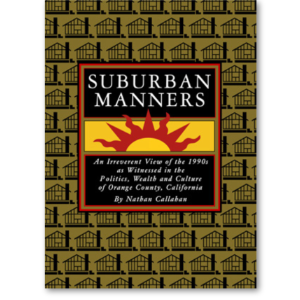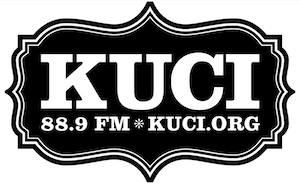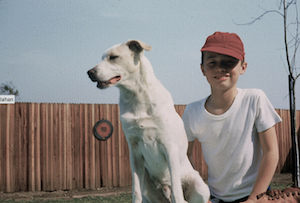The 2010 Applied Brilliance Conference in Ojai, California featured talks on Resilience and Revolution. Among the presenters were Adam Gazzaley, director of the Neuroscience Imaging Center at the University of California; E.C. Krupp, Director of Griffith Observatory; Rafael Lozano-Hemmer, electronic artist; Mark Kingwell, author of the national bestseller Nearest Thing to Heaven; Saul Griffith the Chief Scientist at Other Lab; and Nathan Callahan, who spoke on The Open Air Museum: Visiting Hypereality and the Meaning of Art. Below is the text of that presentation:
—
The German philosopher Theodor Adorno once said, “It is self-evident that nothing concerning art is self-evident.”
Take my friend Carl Diedrich for example. A contemporary of Adorno, Carl was born in Germany in 1918. From an early age, Carl wanted to be a mechanical engineer. By 1938, he was doing just that for the Ford Motor Company in England. But while preparing to travel to another Ford Plant in Eastern Europe, Carl learned that it’s impossible to know what a life will become when it’s beginning. He was stopped at the German consulate in London. His passport was revoked, and German officials gave him a one-way ticket to Berlin. Carl Diedrich was being drafted to serve as an artillerist in the German army during World War II. Carl was young. He loved his country and his heritage. What did he know of the future?
By war’s end, Carl had become part of Germany’s last line of defense. With his back against the walls of Berlin — his family’s hometown — the ensuing bombings claimed the lives of all of the Diedrich women except Carl’s mother and destroyed all of the family’s belongings. As the family’s only surviving male, Carl headed south with his mother to Italy.
The precision gears of circumstance ground on.
In 1945, five days before World War II’s armistice, tiny Costa Rica slyly declared war on Germany and confiscated the land holdings of all German nationals. As a result, the Diedrich family’s only remaining property — a Costa Rica coffee plantation Carl’s mother had inherited after her uncle’s death in World War I — was gone.
Say what you will, the twentysomethings sucked for Carl. At age of 27, Carl Diedrich had lost his country, his job, most of his family, and all of his family’s property.
But Carl was resilient. He approached his life as art in process. Over the course of the next 20 years, he cultivated an interest in coffee, traveled to the Middle East, married, developed a Buddhist nature, moved to the United States, became one of the world’s leading authorities on whale behavior, and later, was employed as a high-rise construction engineer.
It was coffee, however, that inspired Carl — dark as hell, strong as death, sweet as love. Coffee. After an unsuccessful attempt to reclaim his family’s Costa Rica coffee plantation, Diedrich joined a group of investors and purchased another Central American finca. In 1965, Carl, his wife and their five sons moved to Antigua, Guatemala to become coffee exporters.
It was then that something special — something Transcendental — came into Carl’s life. I call it The Open Air Museum. Carl took his circumstances and — in what can only be described as an artistic process — reinvented his world. In 1971, Diedrich bought a VW van. And then spent the off-season traveling north with his family through Mexico and into California – hoping to find a place to establish a coffee importing business.
At a chance stop at a Corona del Mar gas station in Orange County — 120 miles south of here — Carl became convinced that the OC was ripe for the coffee trade. His family relocated there and opened a shop in a rented Costa Mesa garage.
There, Diedrich’s relationship with his van blossomed. They became a single mythical beast, a coffee-bearing centaur. Carl reinforced the van’s drivetrain and transaxle to carry a heavy load of beans, stripped out the interior for maximum cargo space, and added a bench chest with parts for repairs and air horns on the cab’s roof. On the tailgate, he attached a banner fashioned out of fiberglass that read, “Vaya con Dios”: Go with God.
While Carl’s Buddhist nature inhabited the van, the van, in turn, shaped his aesthetics. Its simplicity became an expression of Carl — a kind of simulacrum of the man himself.
Over the next decade,eight times each year, Carl and his van hauled 2,000 pounds – one ton — of green coffee beans on the 1,500-mile pre-National Highway Improvement roads from the Diedrich Coffee Plantation through Mexico to his shop in California.
Before the trendy chain coffeehouses of the early 1990s — with their venti half-caff nonfat no-foam double-cupped lattes — Diedrich refined Orange County’s java palate and primed its psychotropic engines.
Love them or not, Michael Chabon, Jacques Derrida, Gustavo Arellano, Richard Nixon, Frank Gehry, Tiger Woods, Kobe Bryant, Steve Martin, Gwen Stefani, Leo Fender, Jean Baudrillard — who I’ll talk about later — and a host of other, for lack of a better word, trendsetters all got juiced on Diedrich beans in Orange County.
It was sublime. It was the beginning of Diedrich Coffee. But Carl was Zen. He had no master plan. He lived in the moment. The van had transformed him. Now, he saw magic and beauty all around. To Carl the world was an Open Air Museum filled with works of art – everywhere he looked, beautiful expressions of human creative skill and imagination.
By 1983, Carl’s son Martin joined him in his enterprise. The van, sitting in front of their new store, became a landmark. If you found that van, you found the best coffee in the world. Carl was not only delighted by the hard-earned results of his work, but also by the delirious precision of circumstance. Chance. And like art, circumstance sometimes takes us by surprise.
By the 1990s Diedrich Coffee began an expansion plan that slowly perverted the business. As Parkinson’s disease ravaged Carl, Diedrich Coffee went public. A cadre of ex-fast food executives took over management. And while Diedrich Coffee, Inc., became the second largest specialty coffee company in the United States (behind Starbucks), the Diedrich family lost all control. Eventually Carl passed away, and Martin was pushed aside. The name above the door still said “Diedrich Coffee,” but the quality and the magic of Carl’s artistic process were gone.
And the van? What became of the Van? Like Ken Kesey’s Bus, Carl’s van was returned to nature, parked outside in snowy Sandpointe, Idaho, in the backyard of Carl’s son Steve and left to the elements. Vines grew through the van’s interior. Rust formed on the wheels. Mold on seats. The tires rotted. Vaya Con Dios.
When I learned of the van’s fate, in a fit of irrational exuberance, I proposed that the van be brought back to Orange County and put on display at the Newport Harbor Art Museum. Fashioned with pragmatism and love, I considered Carl’s van to be an important work of local art: a shrine to an historic shift in one of the most culturally influential places in southern California, if not America. Carl’s van was a testament not only to utility, but a window into the spirit of reinvention. But there was no interest from the museum. The van, considered to be more artifact than art, was deemed unsuitable for display. It remained in Idaho to return to nature. For me, Carl’s van became a lesson in the future of art — where artistic expression is headed in the 21st century. Let me explain:
Again, I think of Theodor Adorno; art is surely not self-evident. The finished product is certainly not discernable in its origin. More importantly, perhaps meaning is found in the process of art, rather than the product.
We’re at a point in time when nearly everyone has access to producing artistic things. But when replication, sampling, mashups and mixdowns are thought of as art — what becomes of process? The making of art? Does it vanish into a programmed format or does it flourish?
In the traditional sense, art has always been about simulacra — a representation of another thing — real or imagined: the Statue of David, Guernica, Monet’s Water Lilies, Rothco’s White Over Red, Einstein on the Beach, Highway 61.
In that regard, there’s a delightful quote I’d like you to consider about representation and simulacrum. It’s from the notorious 20th century French philosopher Jean Baudrillard, who I mentioned earlier sipping Diedrich Coffee in Orange County.
Here’s the quote: “The simulacrum is never what hides the truth — it is truth that hides the fact that there is none. The simulacrum is true.”
The quote appeared as the epigraph to one of Baudrillard’s most famous works Simulacra and Simulation. It is attributed to the book of Ecclesiastes and ironically, it’s been requoted thousands of times. But more about that in bit.
In a literary sense, the quote can be simplified in the saying “all great stories are true, some actually happened.”
Baudrillard wrote like a mystic. He was the prophet of hyperreality – the modern condition that fancies simulations of reality as experience. You know: Las Vegas. Sampling. Sex Dolls. Second Life. Canned Laughter. Baudrillard foresaw this separation of experience — the distance between what’s real and what’s hyperreal: what’s Main Street in Ojai and what’s Mainstreet at Disneyland; what’s life in reality and what’s life on reality TV.
For centuries before, a simulacrum was defined simply as a representation of what is real. But for Baudrillard a simulacrum was no longer just a representation. It became truth in its own right: the hyperreal. Within this hyperreality, we become so reliant on models and maps that we begin to lose contact with the real world. Our reality begins to imitate the model, which eventually precedes and determines our world. Simulacra then becomes a copy without an original. Like Mainstreet at Disneyland.
The quote attributed to the book of Ecclesiastes tells us that truth is ever illusory, but the symbol — the statue, the painting, the word, the van, the expression — is always true. That’s pretty heady stuff. I mean, if art — or representation — is that which is true, how do we incorporate that truth into our world?
Notably, the most popular traditional definition of art in our culture gave us a hollow answer. It told us that art was both useless in a functional sense and yet of high value. Another popular definition held that art must be made with the intent that it is art to be considered art. It would follow then that art couldn’t be created by chance. It had to be intentionally useless.
As an expression of its earnest futility, the word “art” became codified to mean “fine art” —art with a seal of approval. In the “fine art” coding system, if an object was artistic but functional, it was called “craft” not art. If the object was used in a commercial or industrial way it was called “design” not art.
Over time, with rampant advancements in technology and increases in leisure time, people became more accustomed to functionlessness, and by the 20th century these lines of demarcation — between art, design and craft — began to blur.
Which brings us to Marcel Duchamp’s store-bought urinal and Andy Warhol’s Brillo Boxes — things that certainly weren’t considered art until Andy and Marcel plopped them in a gallery. You really have to admire their cojones. Through their art, they expressed the idea: “If you’re going to tell us that we have to make art with intent, then why the hell can’t we leave out the artistic process and make it all intent.” Such was the relationship between art and culture and seals of approval.
Sadly, these seals of approval — and much of our culture’s relationship to art, led, for some, to a “Hardening of the Attitude” and an overly rigid interpretation of art.
We all know people who have suffered from “Hardening of the Attitude” often called Psychosclerosis. I have family members who are afflicted. Psychosclerosis prevents the sufferer from seeing, dreaming, imagining a range of possibilities. It’s dogmatic, prejudiced, inflexible. The afflicted see art as “self-evident”. In accepting what we are told about what is and is not “art,” we discover nothing; we lose the value of art: the joy of discovery and delight in the flight of fancy.
So, is art really useless? Is art really dogmatic? Or is art transcendent? I believe it’s transcendent. I believe that the truth in art can be found in a place I call the Open Air Museum.
Marshall McLuhan, the messenger of the medium, suggested that art always functions as a “counter-environment” designed to make visible what is usually invisible about a society. In the creative process lift the veil and behold: There is the art. It’s on the other side. In the counter-environment.
By extension, the Open Air Museum gives McLuhan a twist. In the Open Air Museum the “counter-environment” is one and the same with what is real and visible. It’s not a separate reality, but rather an always-present way of perceiving. It tells us that art exists within us. Art — 21st Century Art — is a way of working and of being — a humanized art. Such was Carl’s Diedrich’s world.
The Open Air Museum requires that we are open to our senses. It recognizes beauty wherever it is found, and places less value on what we’re told and more value on what we experience. It is sometimes chance — the delirious precision of circumstance. But above all, it is a process that allows us to live in our works. As they say on the Indonesian island of Bali: “We have no art; we do everything as well as we can.”
Now…. let’s get back to Baudrillard. His quote. “The simulacrum is never what hides the truth — it is truth that hides the fact that there is none. The simulacrum is true.”
A few years ago, I decided to dig a little deeper into that quote — to try and find it in the book of Ecclesiastes. It wasn’t there. So, I contacted biblical scholars — even searched the annotated version of the Apocrypha and the Deutero canonical books of the Bible in hopes that these might be the words of Ecclesiasticus. Still…… no simulacra. Then I found the truth. Online. On a blog. Baudrillard made the quote up. He pulled it right out of his philosophical ass. “I have always used completely imaginary quotations,” Baudrillard said in an obscure interview in 2003 a few years before his death. “The funniest being the one from the epigraph to a chapter in Simulacra and Simulation…. Nobody spotted it,” Baudrillard goes on. “Doubtless, it is impossible to do without references. But they have to return to secrecy. The centre of gravity lies in what we do; that must be our well-spring.”
Today, in an era of replication, the value of art is shifting away from something inherent in the product. Instead, the value of art is refocusing. It is becoming the wellspring of imagination and process that we use to see the world differently. As our preconceptions pass away, the value of art is the ability to recognize beauty and joy all around and to delight in the symbols and expression — and doings— of such awareness.
Baudrillard was showing us that process — the doing — is the heart of art. The art of his expression — his quote — was showing how we make our own rules. No matter how referential the simulacra becomes, no matter how many models are overlaid on what is real, the creative process remains to give things spirit and meaning. “The centre of gravity lies in what we do; that must be our well-spring.” That must be our point of delight.
One more thing.
In 2007, after splitting from Diedrich Coffee, the company that bears his family’s name, Carl’s son, Martin, opened Kean Coffee across the street from the original location of his father’s first store. One day as he was driving up 17th street on his way to the traffic-jammed 405 freeway to pick up a shipment of raw coffee beans in Los Angeles, Martin — completely by chance — strayed off course and ended up winding through the residential streets of Costa Mesa.
Approaching Newport Boulevard something familiar caught his eye. As he drew nearer, Martin’s jaw dropped in astonishment. There sitting in a driveway was his father’s Volkswagen van — airhorns on the cab’s roof; the van that had been left to return to the elements, the van that had vines growing through it. And in its window was a “For Sale” sign.
Martin now pilots Carl’s van through the streets of Orange County. It’s not in the Newport Harbor Art Museum. It’s in The Open Air Museum. And on its tailgate is the same sign as before: Vaya con Dios.








